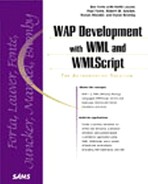Chapter 14. Best Practices
Building applications for wireless devices requires thinking about the Web in a new way. Instead of assuming that end users have a minimum of a 14-inch display and a 28.8Kbps modem, you are constrained much further. Today's devices that are enabled with a WAP browser and rely on circuit-switched data can achieve data transfer rates at a maximum of 9600 baud. Additionally, most devices can only accept decks that fit in a single packet smaller than 1400 bytes and do not perform any packet reassembly. Today's limitations are based not only on the network's speed but also on the phones themselves. You must be very careful about the assumptions you make regarding the end device that is connecting to your application. It might have only a three-line display and only one soft key, and it might not support graphics of any kind. Then again, it might support graphics, have two soft keys, and be able to display eight lines of text at a time. The important thing is to recognize the fact that these characteristics can vary widely, and your application should be able to deal with them. To complicate matters even further, there are still quite a few holes in the WML Specifications from the WAP Forum; as a result, devices can interpret the same code in different ways and still both be valid.
This chapter presents guidelines on how you can write code that will work and render in a useful and meaningful way on the WAP-enabled devices that are on the market today. It also discusses how your application can identify specific characteristics of the device that is making a request of your application and how it can present content that will render in a more usable manner.
